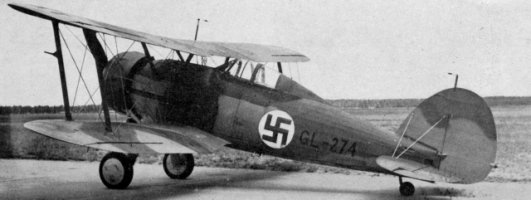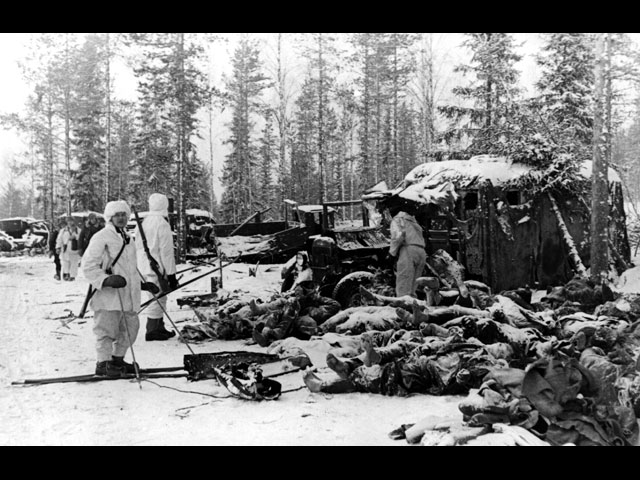Thursday 11 January 1940
 |
| Gloster Gladiator in use in Finland during the Winter War. |
Winter War Army Operations: The Finnish IV Corps (12th Infantry Division and 13th Infantry Division) surround the 34th Tank Brigade, Soviet 168th Division and 18th Rifle Division of Soviet 8th Army north of Lake Ladoga. They call this the "Great Mottie of Kitilä." The weather is good enough for the Soviets to supply the pocket by air, but the men inside are miserable and immobilized. The Finns beat off a Soviet relief attempt and set to work cutting up the pocket as they did near Suomussalmi. Major Matti Aarnio of the 4th Jaeger battalion leads the effort and becomes famous as "Motti-Matti."
At Salla, the Soviets try another attack toward the Kemijarvi-Tornio railway but make a little progress.
Winter War Air Operations: At frozen Lake Kemi, the Swedish volunteer air group, Flygflottilj 19, starts off with a dozen obsolete Gladiator Gloster fighters and 4 Hart light bombers. They are a good match for Soviet airplanes, however, which in general are also obsolete by current standards.
Mechelen Incident: In a fit of pique, Hitler fires General Helmuth Felmy, commander of the air fleet (2d Luftlotte) involved, and also his chief of staff Josef Kammhuber. For the moment, Fall Gelb remains on the docket for 17 January, because nobody knows yet how much the Belgians learned. Several senior officers burn their hands throwing papers into stoves and then retrieving them to see how much remains legible. Hitler issues Fundamental Order No. 1 about the handling of military secrets.
The Belgians attempt to trick Reinberger into thinking they didn't learn anything from the papers so that he will tell that to the German ambassador. This does work for now.
In fact, the Belgians had basically all the information. General Raoul van Overstraeten concludes that the documents are genuine. King Leopold informs the French, via General Gamelin, and the Belgians give them a copy. They also tell Lord Gort, in charge of the BEF. Everyone considers a German attack imminent.
Battle of the Atlantic: U-23 (Oberleutnant zur See Otto Kretschmer) torpedoes and sinks 1,150-ton Norwegian coal freighter SS Fredville east of the Orkney Islands. The bow of the ship remains afloat for some time but eventually sinks. There are five survivors and eleven perish. A Swedish ship picks up the survivors and takes them to Kopervik, Norway.
British freighter SS El Oso hits a mine and sinks 6 miles from the Bar lightship at Liverpool. Three crew perish, 32 survive.
The British at Gibraltar detain US freighter Tripp for inspection.
Convoy OA 70G departs Southend, and OB 70 departs from Liverpool.
European Air Operations: The RAF coastal command attacks three Kriegsmarine destroyers off Jutland, and also protected three British cargo vessels in the same area from Luftwaffe attack.
A Heinkel 111 crashlands in Holland after being shot up by RAF fighters.
The Women's Section of the Air Transport Auxiliary goes into action. The women deliver the first aircraft from factory to depot. Some civilian men who are waiting for a commission into the RAF are unhappy at this employment of women.
French Homefront: "Meatless Fridays" are announced by the government, and sales of beef, veal and mutton are prohibited on Mondays and Tuesdays.
US Military: The Navy conducts an amphibious exercise in Puerto Rico.
China: The Chinese 4th War Area takes Tsunghua.
American Homefront: "His Girl Friday" starring Cary Grant and directed by Howard Hawks is released.
"His Girl Friday" is remade in 1974 as the Jack Lemmon/Walter Matthau comedy "The Front Page."
 |
| Dutch soldiers training on the ice, 11 January 1940. |
January 1940
January 1, 1940: Finns Carve up the SovietsJanuary 2, 1940: Finnish Counterattacks Continue
January 3, 1940: Soviets Trapped
January 4, 1940: Soviet Breakout Attempts Fail
January 5, 1940: Dicing Up the Soviets
January 6, 1940: Soviet 44th Division Runs
January 7, 1940: Shakeup in Soviet High Command
January 8, 1940: Ratte Road Battle Ends
January 9, 1940: British Submarines in Peril
January 10, 1940: Mechelen Incident
January 11, 1940: Finns Surround More Soviets
January 12, 1940: New Soviet Attacks at Taipale
January 13, 1940: Fall Gelb Postponed
January 14, 1940: Japan's Government Falls
January 15, 1940: Soviets Prepare More Carefully
January 16, 1940: German Atrocities Uncovered
January 17, 1940: Bletchley Park in Action
January 18, 1940: New Hope for Allied Shipping
January 19, 1940: Finnish Attacks at Salla
January 20, 1940: Churchill Urges Cooperation
January 21, 1940: Asam Maru Incident
January 22, 1940: Dissension Within British Government
January 23, 1940: Dissension in South Africa
January 24, 1940: NKVD Blocking Detachments
January 25, 1940: Auschwitz Site Selected
January 26, 1940: Millionaire Bunker Destroyed
January 27, 1940: U-20 Sinks Four Ships
January 28, 1940: Softening Up the Finns
January 29, 1940: Moscow Willing to Talk
January 30, 1940: Hitler Throws Down the Gauntlet
January 31, 1940: Timoshenko Is Ready
2019











